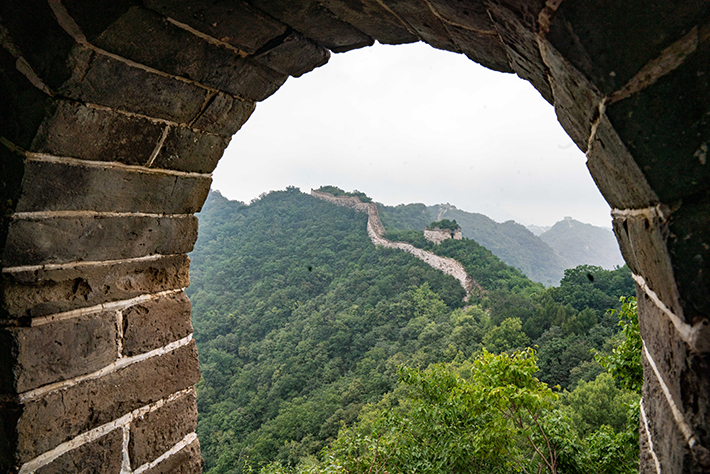|
||||||||||
| Home Nation World Business Opinion Lifestyle ChinAfrica Multimedia Columnists Documents Special Reports |
|
||||||||||
| Home Nation World Business Opinion Lifestyle ChinAfrica Multimedia Columnists Documents Special Reports |
| ChinAfrica |
| The Wonders of the Wall |
| The Great Wall is a powerful symbol that represents the heroic spirit of the Chinese people |
| By Fortune Abang 丨VOL. 15 May 2023 ·2023-04-19 |

Fortune Abang poses for a picture during a visit to the Great Wall on 27 July 2022
While getting a chance to visit the Great Wall of China may not be easy, it is a memorable experience for everyone who manages to get there. And the value of the Great Wall is not confined to tourists; it is also significant for those interested in learning about the preservation of the historic site as a unique symbol of Chinese civilisation.
Even with cable cars and paved steps on the Great Wall, tourists find it tough to reach the peaks as it requires perseverance and strength. In the end, it feels very fulfilling and even heroic to accomplish the feat.
No place I have visited across the world inspired me to learn more about the rich culture and traditional heritage as did China, specifically the story of Chinese civilisation as informed by the Great Wall.
A visit to remember
My first visit to the Great Wall made me feel that it was unimaginable not to want to unravel the many secrets behind the wonders of the Great Wall that spans 21,196.18 km.
The stories and features that surround the Great Wall are so fascinating that if you continue to hear the stories while standing on the wall, you will never cease to be awe-struck.
The Great Wall can best be described as a potent Chinese cultural icon, a symbol of national pride, and an inspiration for modern Chinese art forms including paintings, embroidery, decorative items, photography and post cards.
The Great Wall is a powerful symbol that represents the unification of China. It also represents the ability of Chinese people to work together for the common good of their country. It exemplifies the value of preserving cultural heritage, and the position of China as one of the greatest tourist attractions globally.
The majesty of the Great Wall reflects the wisdom, dedication, sweat and tears that went into building it. For sure, no one would ever doubt the many legends and myths that exist with regard to the building of the Great Wall.
Positioned at the top of high mountains and difficult terrains, the Great Wall has thwarted invasion attempts throughout the history of China. The many extensions of the Great Wall were built over some two millennia across north China.
Also magnificent is the aesthetic scenery and quality of the construction. Rammed earth bricks, stones, and wood from many regions were used for the construction.

A view of the Jiankou section of the Great Wall in Beijing
More than protection
While the Great Wall served as protection against invasions across the historical northern borders of ancient Chinese states and imperial China, defence was not its sole purpose. It was also designed to serve as a communication system.
The Great Wall features beacon towers from which soldiers sent signals using smoke to warn each other about an invading army and the need for reinforcements to repel the attack. They created the smoke by burning wolf dung and mixed different herbs into it to change the colour of the smoke for different signals.
The Great Wall served as a military defence system, and contributed to China’s profound literary culture through sayings, proverbs and idioms associated with it.
The architectural design of watchtowers within troop barracks and garrison stations, the signalling capabilities, and the pathways that served as transportation corridor are all unforgettable features.
Another unforgettable feature is the inscription in Chinese that means, “He who has not climbed the Great Wall is not a true man.” These words from a poem penned by Chairman Mao Zedong could also be interpreted to mean that one who cannot overcome difficulties in life is not a hero. A mere reading of the inscription stirred heroic feelings in me. It symbolises the spirit of Chinese people and their civilisation.
It is not a surprise that the Great Wall was designated as a UNESCO World Heritage site in 1987, as it is generally recognised to be one of the most impressive architectural feats in the history of mankind.
The iconic Great Wall lives in the heart of the Chinese people as a form of collective strength and unity. China’s banknotes and coins carry the image of the Great Wall as a symbol of national culture. More than 100 different kinds of banknotes and coins with pictures of the Great Wall have so far been issued by more than 30 banks in the last 100 years.
The first set of Beijing airmail stamps issued in 1927 includes a picture of a plane flying over the Great Wall. Since then, the Great Wall has featured on ordinary stamps, commemorative stamps, souvenir stamps and collector’s items issued by the State Post Bureau.
Finally, I strongly recommend you to visit the Great Wall to see for yourself how he or she who has not been to the Great Wall cannot claim to be a hero.
The author is principal diplomatic correspondent of News Agency of Nigeria
| About Us | Contact Us | Advertise with Us | Subscribe |
| Copyright Beijing Review All rights reserved 京ICP备08005356号-5 京公网安备110102005860号 |